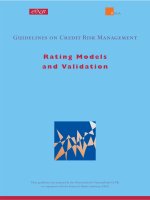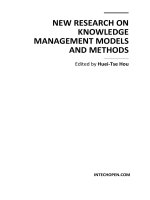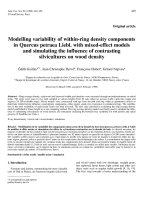Business analystics with management science MOdels and methods by arben asllani ch05
Bạn đang xem bản rút gọn của tài liệu. Xem và tải ngay bản đầy đủ của tài liệu tại đây (2.7 MB, 33 trang )
Chapter 5
Business Analytics
with Goal Programming
Business
Business Analytics
Analytics with
with Management
Management
Science
Science Models
Models and
and Methods
Methods
Arben Asllani
University of Tennessee at Chattanooga
Chapter Outline
Chapter Objectives
Prescriptive Analytics in Action
Introduction
GP Formulation
Example 1: Rolls bakery
Example 2: World Class Furniture
Exploring Big Data with Goal Programming
Wrap up
Chapter Objectives
Discuss the importance of using goal programming models in business
applications
Demonstrate the process of formulating linear and nonlinear goal programming
models
Demonstrate the use of Solver for solving linear and nonlinear goal programming
models
Discuss the concept of aspiration levels and goal priorities
Distinguish between functional variables and deviational variables in goal
programming models
Distinguish between systems constraints and goal programming constraints
Offer practical recommendations for implementing goal programming models in
business settings
Prescriptive Analytics in Action
Airbus is the world’s leading aircraft manufacturer
Goals of the company:
Improve products design
Reduce product development time
Reduce cost
Constraints:
Regulatory environments
Fuel efficiency
Customer expectations
Use of optimization software called MACROS
Enabled engineers to find better design choices for the aircraft with optimum
performance relative to their respective seat and range capabilities
Introduction
Difference of Goal Programming
Seek to achieve multiple goals
A sent of linear or nonlinear constraints
History of Goal Programming
First introduced by Charnes, Cooper and Ferguson in 1955
First described as a decision analysis tool by Lee in 1972
Later expanded by Ignizio in 1974 and Romero in 1991
Schniederjans offered an up-to-date overview in 1995
Jones and Tamiz provided a bibliography in 2010
The value of the objective function in one model becomes a new
constraint until all optimization goals are incorporated
GP Formulation
Components of GP formulation:
A minimization objective function
A set of goal programming constraints
An optional set of system constraints
Non-negativity constraints for functional variables and deviational
variables
Example1:
Rolls Bakery Revisited
The decision maker wants to determine how many dinner roll cases
(DRC) and sandwich roll cases (SRC) to produce in order to maximize
the net profit.
150 machine hours
Each product is produced in lots of 1000 cases.
Products have a different wholesale price, processing time, cost of raw
materials, and weekly market demand.
Example1:
Rolls Bakery Revisited
Recall from chapter 2 that the LP formulation of the above problem is:
Suggest that the company run nine lots of DRC and four lots of SRC
Example1:
Rolls Bakery Revisited
Revisit the same problem with a new set of goals:
Priority 1: Company should not produce more than two lots over the weekly demand for
each product
Priority 2: Company should meet the weekly demand for both products
Priority 3: Company should utilize available machine hours
Priority 4: Company should make the maximum possible net profit
Helpful definition:
Aspiration Level: indicates the desired or acceptable level of objective
Goal deviation: the difference between aspiration level and the actual accomplishment for
each goal
Goal priority: the order of importance for achieving each goal
Sometimes reflect potential penalties for not achieving the goal
GP Formulation Steps:
New set of decision variables
Represent underachievement or overachievement of a given goal
Can be added to represent goals that are not currently represented by the
existing constraints in the LP model
Decision maker needs to incorporate the deviational variables into a GP
objective function and into the newly created or modified constraints
Step-by-step methodology for GP formulation.
Step 1: Formulate the problem as a simple LP model
Step 2: Define deviational variables for each goal
Step 3: Write GP and system constraints
Step 4: Add non-negativity constraints for functional and deviational
variables
Step 5: Determine the variables to be minimized in the objective function
Step 6: Write the objective function with priorities
Step 1: Formulate the problem
as a simple LP model
Step 2: Define deviational
variables for each goal
Goal 1: Company should not produce more than two lots over
the weekly demand for each product
Step 2: Define deviational
variables for each goal
Goal 2: Company should meet the weekly demand for both products
Step 2: Define deviational
variables for each goal
Goal 3: Company should utilize available machine hours
Goal 4: Company should make the maximum
Step 3:
Write GP and system constraints
Step 4: Add non-negativity constraints
for functional and deviational variables
Step 5: Determine the variables to be
minimized in the objective function
To minimize the positive deviational variable, the actual number of machine
hours utilized need to be less than 150 hours
That means that the number of machine hours utilized will not exceed 150 hours
List of deviational variables to be included in the objective function of the GP
model:
Step 6: Write the objective
function
with
priorities
Both goal 1 and goal 2 have the highest priority for the decision
maker (P1=P2=300).
Goal 3 has the second highest priority (P3=20) and goal 4 has the
third priority (P4=10). As such, the objective function of the GP
model can be written as:
Since the optimization algorithm will seek to minimize the value of Z,
the first deviational variables to reduced or even become zero are
those that are associated with the largest values of contribution
coefficients.
Putting it Together
GP Formulation for Rolls Bakery
Solving GP Models with Solver
Model setup and solution for GP model
Solving GP Models with Solver
Solver setup for GP model
Final Solution
The bakery must produce 7.5 lots of DRCs and 6 lots of
SRCs.
The values of the deviational variables indicate whether the
decision maker has reached the stated goals.
Since the value of
resulted in 15, that shows that the
optimal production of rolls required an additional 15 hours to
produce for a total of 150+15 = 165.
Similarly, since s4positive( ) = 2.5 that shows that the goal
of not exceeding five production lots for DRC cases is not
achieved.
Example2:
World Class Furniture
Nonlinear programming models can also be transformed into GP models.
The inventory management example from Furniture World Corporation
To Calculate the weekly order quantity for each furniture category.
Economic Order Quantity (EOQ) model
Storage capacity of 200,000 cubic feet
Purchasing budget of $1.5 million.
Operational data about the inventory management for these five products
NLP Formulation
Recall the NLP formulation of the problem as follows:
(Nonlinear objective function seeking to minimize the overall inventory
holding and ordering cost)
Subject to:
NLP Formulation
The optimal solution.
The warehouse must order 289 tables, 575 chairs, 457 beds,
469 sofas, and 180 bookcases.
This solution reduced the total inventory cost to $6,576.
The solution suggested that the warehouse storage capacity
is a binding constraint and that total inventory and
purchasing cost constraints is not a binding constraint and
has a slack of $254,298









